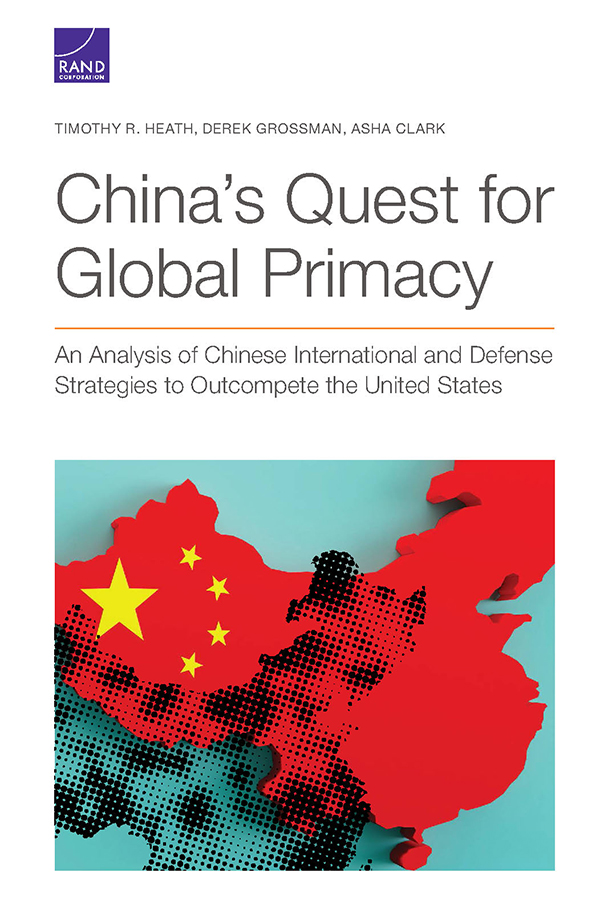Chinese International and Defense Strategies to Outcompete the US
Read Also:- China’s Quest for Global Primacy (Part 1)
The sudden emergence of the COVID-19 pandemic has already shown how unexpected shocks can drive the international situation in unexpected directions. Moreover, China has serious liabilities that could impair its ability to compete with the United States. Some of these have been posited by Chinese analysts and commentators, but others can be deduced by analysis. The most-important vulnerabilities highlighted by Chinese leaders center on the country’s domestic situation.
China continues to face severe economic imbalances, problems of corruption, regional unrest, and daunting demographic challenges. In terms of international attributes, China suffers from a position of disadvantage as the rising power. It has a weaker leadership role in multilateral venues and an inferior influence on global discourse than the incumbent power, the United States. China’s defense strategy has drawbacks as well. The People’s Liberation Army (PLA) remains an unattractive partner for many countries, especially in Asia. And the military’s lack of power-projection capabilities limits its ability to provide the public security goods that helped make U.S. global leadership so successful. These vulnerabilities suggest advantages for the United States, but they also underscore areas that China could address in coming years if it hopes to improve its competitive position. One final point deserves emphasis. The most-critical factors that will determine the outcome of U.S.-China competition are fundamentally domestic.
Which side can build the more technologically innovative and prosperous economy, flourishing and well-governed society, and durable and responsive politics will likely be the side to gain a decisive advantage in competition. A thorough analysis of the potential trajectory of U.S.- China competition would examine such variables closely, but such a task lies beyond the scope of this analysis. The importance of domestic policy should nonetheless be borne in mind when analyzing the international and defense dimensions of competitive strategies.
The research carries several implications for U.S. decision-makers and the Department of Defense (DoD). The first is the enduring importance of strengthening America’s network of alliances and partnerships. China recognizes this network to be a tremendous strategic advantage for the United States, one that Beijing has struggled to match. This analysis has underscored the importance of initiatives undertaken by the past two presidential administrations to shore up U.S. influence and leadership in the Asia-Pacific region. The Indo-Pacific remains a critical domain of U.S.-China competition, and its importance for the broader global competition merits emphasis. U.S. policies that facilitate China’s consolidation of influence and leadership in the Indo-Pacific could simply accelerate Beijing’s efforts to challenge U.S. leadership at the global-systemic level.
The importance of areas outside the Indo-Pacific and of developing countries as constituencies for international leadership deserves emphasis as well. China’s cultivation of client states and influence in the Middle East, Africa, and Latin America could directly affect the ability of the United States to compete in the Indo-Pacific. As one example, Chinese success in consolidating influence with vital energy suppliers in the Middle East could affect the ability and willingness of countries like Japan and India to support measures that constrain Chinese power. The need to bolster the U.S. position in the Indo- Pacific may need to be balanced by the need to uphold U.S. credibility as a global leader. At the very least, closer coordination between competitive strategies both within and outside the Indo-Pacific will be imperative. In terms of developing countries, China’s lack of allies leaves it in a weak position to challenge the United States. Washington could strengthen its hand further by bolstering its relationships with those states that have only recently experienced substantial growth in gross domestic product (GDP). Given the long-term trends favoring the rise of the “non-West,” cultivation of support in the developing world appears prudent in any case.
While multilateral organizations and institutions for global governance have endured considerable criticism for their many failings and inefficiencies, this research has concluded that engagement with those entities will remain an important component of U.S.-China competition. Greater U.S. investments in shaping and reinvigorating international institutions and multilateral venues can help consolidate U.S. influence and restrain Chinese challenges. In some cases, this may involve initiatives to grant China more influence and extend cooperation. The goal here, as in other areas, is to weaken the force of Chinese criticisms by demonstrating responsive, effective U.S. leadership, thereby reducing the incentive for other countries to back Beijing’s efforts to renovate those organizations in ways that harm U.S. interests. In terms of defense strategy, the posited strategy has emphasized the importance of deterrence, crisis management, and military diplomacy in the competition. As presented in this report, China’s defense strategy could expand the geographic range of potential crisis situations and contingencies. Along the Belt and Road Initiative (BRI) routes and as part of the effort to expand a network of client states worldwide, China has a strong incentive to offer arms sales, military training, and other forms of assistance. Such transactions have been increasing in recent years. In coming years, China may take on even more security responsibilities to protect its BRI investments. An imperative to demonstrate its credibility as a patron to client nations could incentivize PLA forces to carry out more-frequent acts of military diplomacy that coerce U.S. allies or partners, or even to contemplate the development of alliance-like obligations.
These possibilities suggest that the U.S. military faces a compelling need to bolster conventional deterrence and invest in capabilities to ensure the superiority of the armed forces in the future. A focus on traditional deterrence through conventional military superiority remains the bedrock of any security strategy to counter China. A robust U.S. military capability to defend its interests and those of its allies and partners provides a critical source of U.S. credibility as a leader in the Indo-Pacific. A strong conventional military capability is also essential for incentivizing regional powers, such as Japan, Vietnam, and others, to resist Chinese coercion and demands. By contrast, clear evidence that the United States had lost the military advantage could persuade other countries to either adopt a position of tacit submission and accommodation to Chinese demands or step up a potentially destabilizing arms race to shore up their defense.
Ensuring the capability to deter China in the short term will remain critical, but investment to ensure long-term advantage will be critical as well. Sustaining investment in the future capabilities of the U.S. military will be essential not just for ensuring the long-term credibility of U.S. deterrence, but also for bolstering America’s position in the broader competition. Finding ways to better protect U.S. interests in the Indo-Pacific but also in the cyber, space, and other domains can backstop broader competitive efforts. DoD may need to maintain a significant presence in the Middle East and other theaters to bolster the U.S. position in the Indo-Pacific as well.
Strengthening U.S. conventional capabilities and investing in a technologically advanced future force remain critical tasks. But military diplomacy could assume greater importance, too. The diplomatic struggle for influence and leadership suggests that the U.S. military could play an important role in incentivizing cooperation with the United States and helping countries resist unreasonable Chinese demands. U.S. experience in military advisory missions and assistance can help strengthen diplomatic partnerships and counter Chinese influence efforts. The provision of public goods, such as security for key shipping lanes and humanitarian aid in the face of disaster, can help maintain the appeal of the United States as the global leader.
As the competition intensifies, U.S. military planners may need to expand the portfolio of possible contingencies involving China. The flashpoints between the United States and China today may not be flashpoints in the future, or they may coexist alongside new ones. Scenarios involving Taiwan, the East and South China Seas, and cyberspace tend to occupy the concerns of military planners today, but these issues may be augmented by new ones that arise from China’s efforts to exert greater leadership, especially along its BRI routes and with client states on other continents. As just one illustration, China’s willingness to court Iran despite U.S. sanctions raises the possibility over time of proxy conflicts between forces backed by China and those by the United States in the Middle East. The more that China assumes the role of patron for client states, the higher the likelihood that, at some point, PLA forces or Chinese-backed host nation forces could engage in hostile acts against parties aligned with the United States.
The appeal and feasibility of Chinese military efforts to resolve longstanding issues, such as Taiwan, may need to be reexamined through the lens of the broader competition as well. From Beijing’s perspective, the potential cost and risk of escalation in war increase the more the competition with the United States intensifies. Thus, it is in China’s interest to delay the resolution of Taiwan’s status and that of other disputed regions until it has prevailed in its competition with the United States. This might mean that Beijing tolerates a stable cross-strait relationship premised on Taiwan’s rejection of formal independence so long as the United States retains the international upper hand and a credible military intervention option. Other PLA missions may be more pressing for the near term. However, the calculus could change, should China succeed in gaining a decisive competitive advantage in international and regional leadership and in its military posture near Taiwan. Similarly, China may regard as satisfactory a continued reliance on gray-zone tactics that incrementally change the status quo within the first island chain in a low-risk manner while it prioritizes efforts to weaken the U.S. position in Asia and elsewhere. To maximize deterrence and the protection of U.S. interests, the defense and foreign policy dimensions of any U.S. competitive strategy may need to be even more closely coordinated.
Any Chinese deliberation on how to tailor the controlled use of force in any confrontation involving U.S.-backed forces would carry serious risks, of course. The dangers of escalation and miscalculation paradoxically underscore the importance of finding ways for both countries to cooperate and ease tensions as a component of successful competition. The development of a strategy that includes some degree of reassurance and cooperation could help stabilize the competition and reduce risks of miscalculation and dangerous incidents. Moreover, as the international security environment experiences more fragmentation and breakdown, collaboration between the world’s two largest powers could prove nearly unavoidable in any case.
The return of great-power competition after decades of unchallenged U.S. global primacy has introduced new challenges and risks. Washington enters the contest burdened by fiscal strains, domestic political polarization, and competing international and domestic priorities. These constraints raise the imperative of developing effective strategies that allocate resources efficiently and effectively. The derivation of a Chinese strategy can, hopefully, provide a useful tool for that important task.
Read Also:- China’s Quest for Global Primacy (Part 1)


















